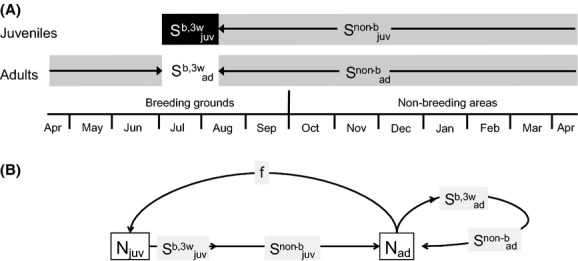Figure 2.

Illustration of the population model used to estimate age-and stage-specific survival of barn swallows. (A) Age-and stage-specific rates in the model as experienced within the life cycle of barn swallows, shown for adult birds and juveniles, respectively. (B) Age-and stage-specific rates as represented in the population model. The adult population in the year t + 1 was considered to be the sum of the surviving juveniles and adults from year t. Surviving juveniles were estimated by considering fecundity (reproduction rate f, leading to the number of juveniles of year t;Njuv), postfledging juvenile survival ( ), and juvenile nonbreeding survival (
), and juvenile nonbreeding survival ( ). Surviving adults were estimated using adult survival in the breeding (
). Surviving adults were estimated using adult survival in the breeding ( ) and in the nonbreeding areas (
) and in the nonbreeding areas ( ). The focal parameter of the model was juvenile nonbreeding survival, whereas for all other parameters, estimates from own empirical data or from literature were available.
). The focal parameter of the model was juvenile nonbreeding survival, whereas for all other parameters, estimates from own empirical data or from literature were available.
